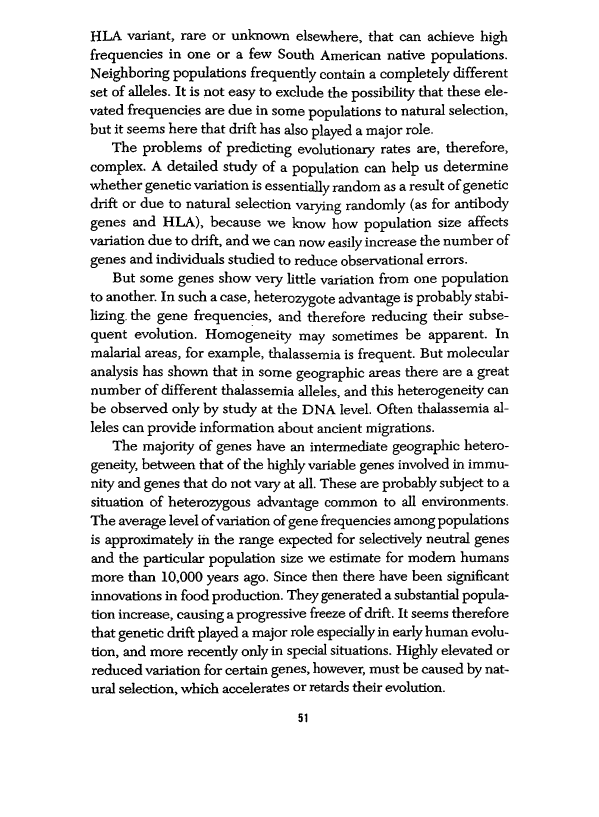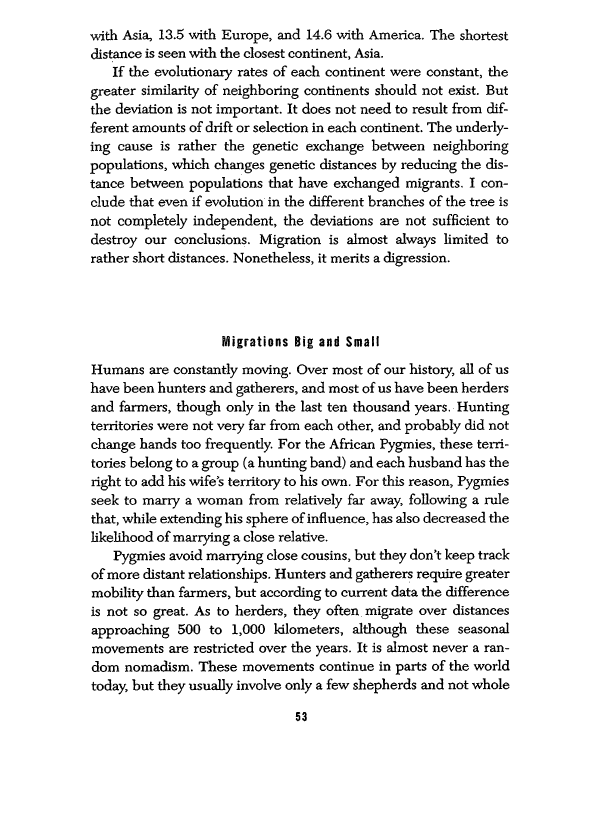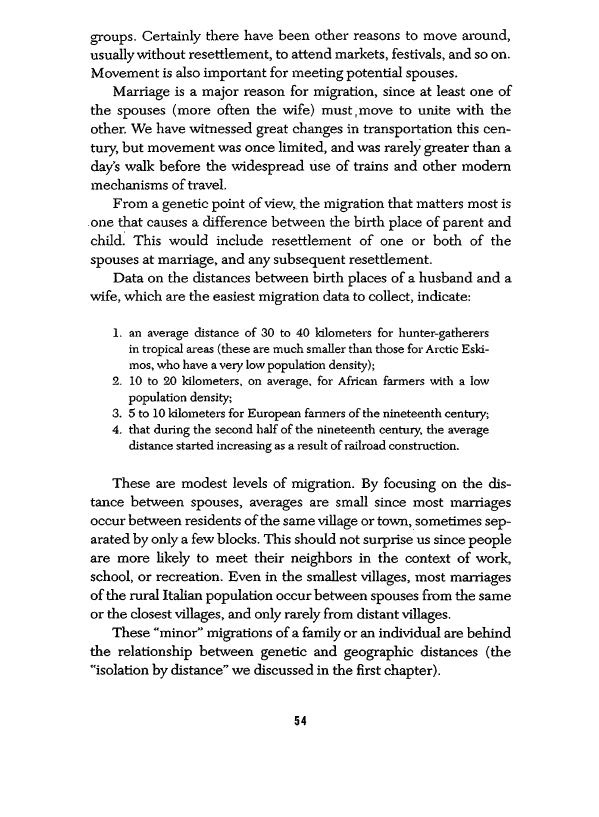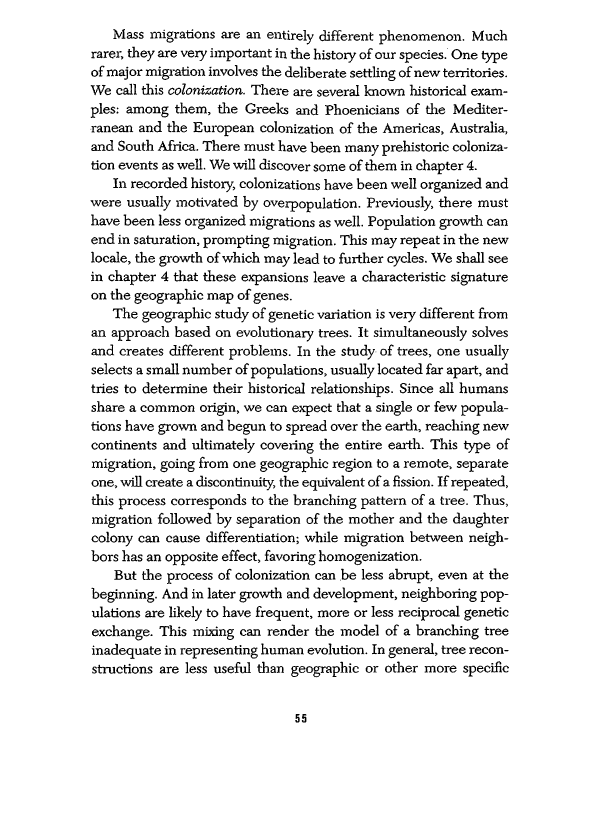Cavalli-Sforza Luigi Luca. Genes, Peoples and Languages
Подождите немного. Документ загружается.


to attain with their animals. This
is
frequently a counterproductive
effort. Breeders know that by seeking genetic
purity through
repeated crossings between closely related
animals-inbreeding-
they dangerously reduce
the
animals' resistance to disease. The
revers&-outcrossing-is
more desirable since racial mixing in all
species generally increases disease resistance
and
overall viability.
This phenomenon is known
as
"hybrid vigor."
When
considering
the
hybridization
of
a single gene, one speaks
of
heterozygote
advantage. A heterozygote
is
an individual who receives different
forms
of
a gene from father and mother.
The classic example
of
heterozygous advantage is sickle cell ane-
mia, which affects mostly,
but
not exclusively, Africans. Consider a
parallel example, common in people
of
southern European origin: a
gene responsible for a genetic disease called thalassemia, a severe
anemia that usually kills before reproductive age
is reached. The
gene shows
up
in two slightly different forms,
or
alleles: normal N,
and abnormal T (causing thalassemia). There are
three
possible
genetic types:
NN: individuals who receive
the
normal gene N from both parents are
"normal" homozygote •.
NT:
those who get a normal allele N from one parent
and
a thal-
assemia gene T from the other are
heterozygote.. Like normal
homozygotes,
they
do
not have
the
disease (but can be identified
through simple laboratory blood tests).
TT:
persons who receive a thalassemia allele from both parents are
homozygote.
for
1;
the
abnormal gene, and have
the
disease .
.
In
some European populations, for instance in the Italian
province
of
Ferrara, located between Venice
and
Bologna, one
of
approximately one
hundred
children
is
born with thalassemia.
Nearly all those afflicted
die young. Heterozygotes are 18 percent
of
the population
and
the
rest, 81 percent,
are
normal homozygotes.
The
important question
is:
why do so many people have
the
dis-
ease, since they inevitably
die before they reach adulthood? They
are obviously
at
a selective disadvantage, and
the
disease should
disappear through natural selection.
The
reality is, however, more
41

complicated;
the
province
of
Ferrara
has also beell affected for many
centuries
by a highly lethal infectious disease, malaria.
It
so happens
that heterozygotes for thalassemia are resistant to it, although normal
homozygotes frequently succumb
to
the
infections.
The
incidence
of
malaria in
the
Ferrara
region was so high ,until World War II,
that
about one out
of
ten normal homozygotes died from it, while het-
erozygotes almost always survived it. Given these numbers
and
a few
calculations
we
might see
that
an
equal proportion
of
N genes
and
of
T genes disappears at every generation,
the
first because
of
malaria
"and
the
second because
of
thalassemia. Therefore, until
there
is
malaria
of
sufficient strength, thalassemia remains
at
a stable fre-
quency in
the
population.
The
thalassemia allele gives
the
population
some
protection from malaria:
in
fact,
it
saves 8.1 percent
of
the
N
homozygotes who would otherwise
die because
of
malaria,
at
the
cost
of
a smaller
number
of
deaths (1 percent) because
of
thalassemia.
If
malaria disappears, thalassemia will also disappear,
because
normal homozygotes
and
heterozygotes will survive
at
the
same
rate, while homozygous
TT
will continue to die young.
As
malaria
becomes
more
or
less intense,
the
frequency
of
the
thalassemia
gene
will increase
or
decrease.
We have said this type
of
natural selection is called heterozygous
advantage.
Whenever
the
two homozygotes survive
or
reproduce
less
than
the
"heterozygote,
the
two alleles will remain in
the
popu-
lation
and
adjust
their
frequencies automatically to values such
that
equal proportions
of
the
two genes survive every generation. At this
pOint, which may
be
reached
after
a relatively few generations have
passed, tlle relative frequencies
of
the
two alleles,
and
therefore
of
the
three
genotypes,
do
not
change any further.
Sickle cell anemia
is
a disease tllat shares many features with thal-
assemia,
and
is especially frequent in people
of
Mrican, Arabic,
and
Asian Indian origin.
In
the
case
of
genes like those producing thal-
assemia,
of
which
there
are many different types,
or
sickle cell ane-
mia,
the
mutant
has
no
chance
of
reaching a high frequency, since its
incidence
is governed
by
a delicate equilibrium between
the
selec-
tive advantage
of
the
heterozygotes
and
the
usually serious disadvan-
tage
of
diseased homozygotes.
Malaria-especially
if
it
is caused
by
48

the most virulent parasite, Plasmodium falciparum--is a
velY
severe
illness producing an anemia
that
lowers
the
body's resistance to other
infectious diseases.
For
this reason it is especially lethal among chil-
dren.
Several different genes can increase malarial resistance; they
are primarily found
at
high
frequencies
in
those populations that
have lived with some type
of malaria for at least fifteen
or
twenty cen-
turies.
This
is
the
amount
of
time it takes for natural selection
to
reach stable gene frequencies as high as those found in many popula-
tions that have
been
subject to serious endemic conditions
of
malaria.
We do not know how many genes e""perience heterozygous
advantage,
but
it
is
one
of
the
factors that make "racial purity" impos-
sible:
This type
of
natural selection will always maintain heterogene-
ity for a gene in a population until heterozygotes are at an advantage.
Genetic
variation
between
Populations
We have very few direct measures
of
evolutionary rates because we
don't know
the
gene frequencies
of
past
generations. However, we
do know how genes
vary in space,
and
there
is a close connection
between variation in time
and
space.
On
this basis it is clear that
the
rate
of
evolution differs greatly among genes.
If
we knew
the
effective population size and
the
intensity
of
migration for
the
entire history
of
our
species,
and
if
we knew
whicll genes were subject to natural selection, we could predict the.
distribution
of
genetic variation across
the
globe.
The
nature
of
drift would make this only a probabilistic prediction.
In
general, we
would expect
the
same level
of
variation
at
any
gene
since the popu-
lation size for every gene would
be
the
same. Natural selection,
when present, could
reduce
or
increase
the
rate
of
evolutionary
cIlange.
But
different genes are subject to very different intensities
of
selection,
and
there
are
many genes
that
show no sign
of
it.
Other
factors could limit
the
effect
of
drift. Because
of
migration,
genetic exchange among populations almost
always
occurs, most
often between closely neighboring villages.
This migration (also
49

called gene
flow)
tends
to
reduce genetic variation between villages .
.
If
it were extremely high,
there
would
be
no genetic dilferences
between villages, nations,
or
even continents;
but
levels
of
migration
that would wipe
out
genetic dilferences between populations clearly
have
not
occurred. A high mutation rate could have an effect similar
to migration,
but
the
majority
of
genes that we have studied have a
rather low mutation rate. We can usually
recognize genes with a high
mutation rate, because they have a higher
number
of
alleles.
Among
the
genes
that
show
the
greatest geographic variation
are
the
immunoglobulin genes (which produce antibodies,
keyele-
ments in
the
body's defense against infectious disease). Because
there
is considerable geographic variation in
the
distribution
of
dis-
ease,
it
is no surprise
that
we find important geographic variation in
the
genes
that
defend
us from these diseases.
As
a result, we might
expect patterns very different from those produced
by
drift.
But
the
great variety
of
infectious diseases,
and
the
genes
that
protect us
from them, also play
the
evolutionary
game-bacteria,
viruses,
and
paraSites are constantly mutating to evade
our
defenses.
The
effect
of
this random arms race is very similar to drift
in
the
sense
that
chance plays a major role in creating gerietic variation
of
pathogenic
organisms
but
is
not
affected
by
human
population size
to
the
same
extent as are selectively neutral genes.
It
is therefore easy to under-
stand
why
the
results from
an
evolutionary analysiS
of
immuno-
globulins are similar
to
those obtained from
the
analysis
of
genes
governed
by
effective population size (i.e., drift), except
that
their
overall rate
of
change is greater.
The
same goes for
the
HLA genes, an important
and
even
more
variable class
of
genes
that
are involved in
our
immunolOgical. indi-
viduality,
and
also in
our
immune defenses against infectious dis-
ease.
The
situation
here
is more complex.
The
HLA genes have
many alleles;
some
of
them
are found everywhere,
and
others
are
restricted
to
particular regions.
The
most unusual
pattern
of
varia-
tion (above all for HLA,
but
also for
other
genes) is found in
the
indigenous populations
of
South America, which generally show
the
greatest geographic variation. Almost all
other
populations in
the
world have a great variety
of
HLA alleles,
but
there
is a single
50

HLA variant, rare
or
unknown elsewhere,
that
can achieve high
frequencies in
one
or
a few South American native populations.
Neighboring populations frequently contain a completely different
set
of
alleles.
It
is
not
easy
to
exclude
the
possibility
that
these ele-
vated frequencies
are
due
in some populations
to
natural selection,
but
it seems
here
that
drift has also played a major role.
The
problems
of
predicting evolutionary rates are, therefore,
complex. A detailed study
of
a population can
help
us determine
whether
genetic variation is essentially random
as
a result
of
genetiC
drift
or
due
to
natural selection varying randomly (as for antibody
genes
and
HLA), because
we
know how population size affects
variation
due
to
drift,
and
we
Can
now easily increase
the
number
of
genes
and
individuals studied
to
reduce observational errors.
But
some
genes show very little variation from
one
population
to
another.
In
such a case, heterozygote advantage is probably stabi-
lizing.
the
gene
frequencies,
and
therefore reducing
their
subse-
quent
evolution. Homogeneity may sometimes
be
apparent.
In
malarial areas, for example, thalassemia is frequent.
But
molecular
analysis
has shown
that
in
some geographiC areas
there
are a great
number
of
different thalassemia alleles, and this heterogeneity can
be
observed only by study
at
the
DNA
level. Often thalassemia al-
leles can provide information about ancient migrations.
The
majority
of
genes have an intermediate geographiC hetero-
geneity,
between
that
of
the
highly variable genes involved
in
immu-
nity and genes
that
do
not
vary at all. These are probably subject
to
a
situation
of
heterozygous advantage common to all environments.
The
average level
of
variation
of
gene frequencies among populations
is approximately
in
the
range expected for selectively neutral genes
and
the
particular population size we estimate for modem humans
more
than 10,000 years ago. Since then there have
been
Significant
innovations
in
food production. They generated a substantial popula-
tion increase, causing a progressive freeze
of
drift.
It
seems therefore
that
genetic drift played a major role especially
in
early
human
evolu-
tion,
and
more
recently only
in
special situations. Highly elevated
or
reduced variation for certain genes, however, must
be
caused by nat-
ural selection, which accelerates
or
retards their evolution.
51

Constancy of
Average
Evolutionary
Rates
Our
task in reconstructing evolutionaty trees would
be
greatly sim-
plified
if
we could
be
sure
that
the
rate
of
evolution-calculated
as
the
mean
of
many.genes (excluding genes subject
to
strong
selection)-is
approximately
the
same in different branclles
of
the
evolutionaty tree. We have given an
idea
of
the
factors
that
can
influence
the
rate
of
evolution.
Do
we
have
the
ability to ensure
that
reality is
as
simple as
our
hypotheses?
We have
seen
in a table
of
genetic distances that Aftica is genet-
ically
the
most distant continent from all
the
·others.
In
effect,
the
distance
between
Aftica
and
the
four
other
continents is 21.7 ± 1.7,
almost double
the
distance
between
Oceania and
the
three
other
continents, 12.7 ± 1.4
eacl1.
This indicates
that
the
difference
between
the
means, 9.0, is well above
the
level
of
statistical error.
The
other
distances are all
much
smaller.
There
is an excellent his-
totical explanation for this result,
whicl1
we
shall see later.
In
order
to examine
the
problem
of
the
constancy
of
evolu-
tionalY rates,
we
can look at
the
distances between Aftica
and
the
other
continents: 24.7 with Oceania, 20.6 with Asia, 16.6 with
Europe,
and
22.6 with America.
It
is clear
that
the
shortest distance
is
between
Aftica and Europe, followed by that between Africa
and
Asia.
If
the
rate
of
evolntion were truly constant,
the
four values
would
be
identical (within
the
limits
of
statistical
error
due
to small
sample size).
The
distance from
Europe
is anomalously
low.
North Africa is
populated with Caucasoid people like Europeans,
but
we
have
made sure to eliminate these populations
and
are restricting our-
selves to
sub-Sallaran Africa.
The
Simplest explanation is
that
sub-
stantial exchange has taken place between nearby continents,
probably via migrations in both directions.
Other
comparisons should convince us
that
the
proximity
of
the
two continents contributes to
their
genetic similarity. Asia, for exam-
ple, Africa's
other
neighbor, is genetically closer to Africa than is
either America
or
Oceania. Compating genetic distances between
Oceania
and
the
other
continents,
we
have a similar situation: 10.0
52

with Asia, 13.5 with Europe,
and
14.6 with America.
The
shortest
distance is seen with
the
closest continent, Asia.
·If
the
evolutionary rates
of
each
continent
were
constant,
the
greater
similarity
of
neighbOring continents should
not
exist.
But
the
deviation is
not
important.
It
does
not
need
to result from dif-
ferent
amounts
of
drift
or
selection
in
each
continent.
The
underly-
ing cause is
rather
the
genetic exchange
between
neighboring
populations, which changes genetic distances
by
reducing
the
dis-
tance
between
populations
that
have exchanged migrants. I con-
clude
that
even
if
evolution·
in
the
different branches
of
the
tree
is
not
completely
independent,
the
deviations
are
not
sufficient to
destroy
our
conclusions. Migration is almost always limited
to
rather
short distances. Nonetheless,
it
merits a digreSSion.
Migrations
Big
and
Small
Humans
are
constantly moving.
Over
most
of
our
history, all
of
us
have
been
hunters
and
gatherers,
and
most
of
us have
been
herders
and
farmers, though only
in
the
last
ten
thousand years.
Hunting
territories
were
not
very far from
each
other,
and
probably did
not
change
hands
too
frequently.
For
the
African Pygmies,
these
terri-
tories belong to a
group
(a
hunting
band)
and
each
husband
has
the
right to
add
his wife's territory
to
his own.
For
this reason, Pygmies
seek
to
marry a woman from relatively far
away,
follOwing a rule
that, while extending his
sphere
of
influence, has also decreased
the
likelihood
of
marrying a close relative.
Pygmies avoid marrying close cousins,
but
they
don't
keep
track
of
more
distant relationships.
Hunters
and
gatherers require greater
mobility
than
farmers,
but
according
to
current
data
the
difference
is
not
so great. As to herders,
they
often
migrate
over
distances
approaching
500
to
1,000 kilometers, although these seasonal
movements
are
restricted over
the
years.
It
is almost never a ran-
dom
nomadism.
These
movements continue in parts
of
the
world
today,
but
they
usually involve only a few shepherds
and
not
whole
53

groups. Certainly
there
have
been
other
reasons
to
move
around,
usually
without
resettlement,
to
attend
markets, festivals,
and
so on.
Movement
is also
important
for
meeting
potential
spouses.
Marriage is a
major
reason for migration, since
at
least
one
of
the
spouses
(more
often
the
wife)
must,move
to
unite
with
the
other.
We
have witnessed
great
changes in transportation this
cen-
tury,
but
movement
was
once
limited,
and
was rarely
greater
than
a
day's walk
before
the
widespread
use
of
trains
and
other
modem
mechanisms
of
travel.
From
a genetiC
point
of
view,.
the
migration
that
matters most is
.
one
that
causes a difference
between
the
birth
place
of
parent
and
child~
This
would
include
resettlement
of
one
or
both
of
the
spouses
at
maniage,
and
any
subsequent
resettlement.
Data
on
the
distances
between
birth
places
of
a
husband
and
a
wife, which
are
the
easiest migration
data
to
collect, indicate:
1. an average distance
of
30 to 40 kilometers for hunter-gatherers
in tropical areas
(these
are
much
smaller than tb.ose for Arctic Eski-
mos, who have a very low population denSity);
2. 10 to 20 kilometers,
on
average. for Africa" farmers with a low
population
denSity;
3. 5 to 10 kilometers for European fanners
of
the
nineteenth century;
4. that during
the
second half
of
the
nineteenth century,
the
average
distance started increasing as a result
of
railroad construction.
These
are
modest
levels
of
migration. By
fOCUSing
on
the
dis-
tance
between
spouses, averages are small since
most
marriages
occur
between
residents
of
the
same
village
or
town,. sometimes
sep-
arated
by
only a few blocks. This should
not
surprise us since
people
are
more
likely
to
meet
their
neighbors in
the
context
of
work,
school,
or
recreation.
Even
in
the
smallest villages,
most
marriages
of
the
rural Italian population
occur
between
spouses from
the
same
or
the
closest villages,
and
only rarely from distant villages.
These
"minor" migrations
of
a family
or
an
individual
are
behind
the
relationship
between
genetic
and
geographic distances
(the
"isolation
by
distance"
we
discussed
in
the
first chapter).
54

Mass migrations are an entirely different phenomenon. Much
rarer, they are very important in
the
history
of
our
species:
One
type
of
major migration involves
the
deliberate settling
of
new
territories.
We call this
colonization. Thel'e are several known historical exam-
ples: among them,
the
Greeks and Phoenicians
of
the
Mediter-
ranean
and
the
European colonization
of
the
Americas, Australia,
and
South Mrica.
There
must have
been
many prehistOriC coloniza-
tion events
as
well. We will discover some
of
them
in
chapter 4.
In
recorded history, colonizations have
been
well organized and
were usually motivated by overpopulation. Previously,
there
must
have
been
less organized migrations
as
well. Population growth can
end
in saturation, prompting migration. This may
repeat
in
the
new
locale,
the
growth
of
which may lead to further cycles. We shall see
in chapter 4
that
these expansions leave a characteristic signature
on
the
geographic map
of
genes.
The
geographic study
of
genetic variation is very different from
an approach based
on
evolutionary trees.
It
simultaneously solves
and
creates different problems.
In
the
study
of
trees,
one
usually
selects a small
number
of
populations, usually located far apart, and
tries to determine their historical relationships.
Since all humans
share a common origin, we can expect that a
Single
or
few popula-
tions have grown and begun to spread over
the
earth, reaching new
continents
and
ultimately covering
the
entire earth. This type
of
migration, going from
one
geographic region to a remote, separate
one,
will create a discontinuity,
the
equivalent
of
a fission.
If
repeated,
this
process corresponds to
the
branching
pattern
of
a tree. TllUs,
migration followed by separation
of
the
mother
and
the
daugllter
colony can cause differentiation; while migration between neigll-
bors has an opposite effect, favoring homogenization.
But
the
process
of
colonization can
be
less abrupt, even at the
beginning. And in later
growth
and
development, neighboring pop-
ulations are likely to have frequent, more
or
less reciprocal genetic
exchange. This mixing can
render
the model
of
a branching
tree
inadequate in representing
human
evolution.
In
general,
tree
recon-
structions are less useful than geographic
or
other
more specific
55

methods,
but
they help give a sense
of
the
similarities
of
popula-
tions, and sometimes even help recognizing admixture.
An
important control
on
the
validity
of
an evolutionary
tree
is
that
all
the
genes
or
charilcteristics used point
to
the
same result
or
at
least have
an
explicable difference.
If
enough genes have
been
studied in widely separated populations
and
statistical tests are
used to verify
the
stability
of
results, we often find strong support
for a
tree
structure. Some individual branches may pose problems.
Very short branches may
be
found for populations generated by
admixtures,
or
affected by long lasting gene flow from neighbors. In
these cases,
the
position
of
the
relevant branch may also
be
shifted
toward
the
center
of
the
tree; for instance, capital cities which have
experienced
much
immigration from all
or
most
other
parts
of
a
country usually occupy a central place in a
tree
of
the
country.
The
length
of
a branch can also
be
affected by drift. A population that
has
had
a very small
number
of
founders,
or
later demographic bot-
tlenecks, may show an inordinately long branch.
Even
when
independent samples
of
genes show substantial sim-
ilarity, there
are
also differences that may
be
very informative.
The
genetic markers mostly used untii now are proteins,
the
gene prod-
ucts rather than
the
genes themselves.
The
more recent markers
employed in the direct study
of
the
DNA present many advantages
over protein markers, again, with only one
drawback-they
have
been
studied in only a few populations, while many protein markers
have
been
examined
in
thousands
of
different populations.
Many difficult problems remain before
we
can satisfactorily
resolve questions in human evolution through
the
analysis
of
living
organisms alone.
We
shall devote
the
next chapter
to
a critical study
of
the
problems that arise during comparisons
of
data from differ-
ent
genetic systems
and
archeological results
that
can help us
reconstruct history
by
another means.
